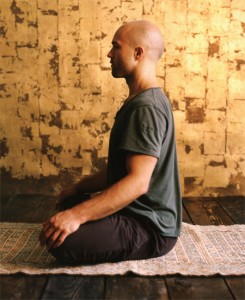Let’s talk about your pelvis. You know—that big bony area at the geographic center of your body. Odds are good that you take it for granted. You may even be annoyed by the bony pokey-ness of it when you sit. Perhaps you think the less you feel your pelvis, the better.

In defense of the pelvis, without it, you could not stand, sit, or walk; even lying down would be difficult. The human pelvis is built for movement. In an adult a total of 13 to 15 bones comprise your pelvic girdle. Add thighbones to that and you have as many as 17 bones working together. Then consider its 5 joints, 18 ligaments, and 72 muscles, all working together to create the miracle of the lightweight, flexible, movable, stabilizing structure we call the “pelvis.”
Why do you care? Because what you know about your pelvis, and what you do with it—or don’t do with it—can have a big impact on your capacity to sit in meditation.
Between a rock and a hard place: the sciatic nerve
The sciatic nerve exits your spine and continues down the back of your leg to end at your heel and toes. It has many offshoots, providing sensory connection throughout the leg. Just after it leaves the spine, the nerve passes through your pelvis, between your hipbone and sacrum; in other words, it’s between a rock and a hard place. It is fairly easy for the sciatic nerve to be pinched between these two bones, especially as we age and the pelvis begins to solidify. If the muscles in your pelvis are tight, this will make the situation worse.
The joints between the sacrum and the hipbone fuse at about 45 years of age in men and 55 in women. Without a regular body movement practice, the muscles will be chronically tight, increasing the odds of pinching the sciatic nerve. Sciatica in men over 45 is often a result of a rigid pelvis and chronically tight muscles that do not know how to relax. It can be difficult to relieve, and it becomes impossible to sit. If the sciatic nerve is continually compressed, the leg muscles will weaken, and in time it can become problematic to stand or walk. It is not a good idea to sit with sciatica for more than a few minutes.
What is Sciatica?
Have you ever felt a burning sensation or numbness in the back of your leg or buttock? It might run the length of your leg or be isolated to a portion of your inner leg, ankle, or foot. All of these qualify as sciatica. Sciatica can also develop in people who are overly flexible, have hyper-mobile joints, pregnant women, or those who have experienced a lower back or pelvic injury.
Move it or lose it
So, what helps? Movement can make a big difference, especially conscious nonlinear body movement: practices like yoga, Tai chi, chi kung, and different forms of dance that bring us out of habitual patterns and require us to pay attention through moving our bodies in new ways. As we age, the ways we move our bodies become more habitual. We use certain muscles over and over, strengthening and tightening them while neglecting others. Add to this the reality of gravity continually bearing down on you and compressing your body, and you have a situation ripe for injury.
While the idea of moving in unfamiliar ways may feel more difficult as we age, it is still possible. The more frequently we move the body, the easier it becomes. Both muscle cells and brain cells can learn new tricks throughout our lifetime. It is a quality of potential that exists in every cell of the body as long as we are alive.
When we pay attention to our movement, our minds and bodies become integrated. This is profoundly healing, and the odds of injury lessen dramatically. We relax. We become calm, concentrated, and as a result, joyful. It makes us happy to pay attention when we move.
Lest you think all of this nonlinear body movement practice is taking you away from your meditation cushion, please know that this is the Buddha’s teaching in action. Your body is your immediate, ever-present teacher and a vehicle for transforming your mind. Don’t let it go to waste.
Even 15 to 20 minutes of conscious nonlinear body movement daily can make a big difference in preventing and relieving sciatica. Taking a few minutes several times a day to move your pelvis in unusual ways. This will remind your body and mind of the possibility of stepping into new habits. Start now—it is not too late to change your ways.
Thank you for subscribing to Tricycle! As a nonprofit, we depend on readers like you to keep Buddhist teachings and practices widely available.